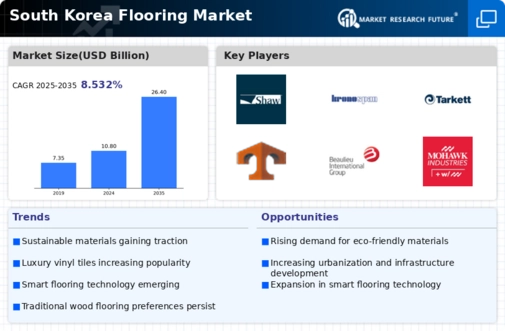Rising Construction Activities
The flooring market in South Korea is experiencing a surge due to increased construction activities. The government has initiated various infrastructure projects, which has led to a heightened demand for flooring materials. In 2025, the construction sector is projected to grow by approximately 5.2%, driving the need for diverse flooring solutions. Residential and commercial buildings are being developed at an unprecedented rate, necessitating innovative flooring options that cater to aesthetic and functional requirements. This growth in construction activities is likely to bolster the flooring market, as builders and architects seek durable and stylish flooring materials to meet consumer preferences.
Consumer Preference for Aesthetics
In South Korea, there is a notable shift in consumer preferences towards aesthetically pleasing flooring options. The flooring market is witnessing a demand for products that not only serve functional purposes but also enhance the visual appeal of spaces. As homeowners and businesses increasingly prioritize interior design, the market for luxury vinyl tiles and engineered wood is expanding. Reports indicate that the demand for high-quality flooring materials has risen by 15% in the last year alone. This trend suggests that manufacturers must innovate and diversify their offerings to cater to the evolving tastes of consumers, thereby impacting the overall growth of the flooring market.
Regulatory Standards and Compliance
Regulatory standards are increasingly shaping the flooring market in South Korea. The government has implemented stringent regulations regarding building materials, focusing on safety, durability, and environmental impact. Compliance with these standards is essential for manufacturers aiming to succeed in the competitive landscape. As regulations evolve, companies must adapt their product offerings to meet these requirements, which may involve investing in higher-quality materials and production processes. This focus on compliance not only ensures consumer safety but also enhances the reputation of brands within the flooring market, potentially leading to increased market share and consumer trust.
Technological Innovations in Flooring
Technological advancements are playing a crucial role in shaping the flooring market in South Korea. Innovations such as smart flooring solutions, which integrate sensors and IoT technology, are gaining traction among consumers. These products offer enhanced functionality, including temperature regulation and moisture detection, appealing to tech-savvy homeowners. The market for smart flooring is expected to grow by 20% annually, reflecting a broader trend towards integrating technology into everyday living spaces. As manufacturers invest in research and development, the introduction of new materials and technologies is likely to redefine consumer expectations and drive growth in the flooring market.
Sustainability and Eco-Friendly Products
The flooring market is increasingly influenced by the growing demand for sustainable and eco-friendly products in South Korea. Consumers are becoming more environmentally conscious, leading to a preference for flooring materials that are sourced responsibly and have minimal environmental impact. The market for bamboo and recycled materials is expanding, with sales projected to increase by 10% in the coming years. This shift towards sustainability is prompting manufacturers to adopt greener practices and develop products that align with eco-friendly standards. As a result, the flooring market is likely to see a rise in the availability of sustainable options, catering to the preferences of environmentally aware consumers.
























Leave a Comment